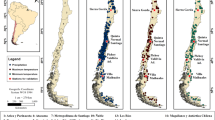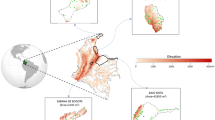Abstract
Air temperature and precipitation data from three high mountainous Bulgarian stations were used as well as outputs from nine regional climate models (RCMs) for air temperatures and eight RCMs for precipitation. Data from 40-year experiments driven by the ERA-40 reanalysis (temporal coverage from 1961 to 2000) of the ECMWF were employed for calibration of statistical downscaling models. Statistical methods were used in this research—Spearman and Pearson correlation, Mann–Whitney test, multiple linear regression, generalized linear models, etc. Projections, based on SRES A1B scenario and RCMs driven by four different GCMs, were made for the following future 30-years periods: 2005–2034, 2035–2064, and 2065–2094. RCMs ETHZ-CLM, DMI-ARPEGE-HIRHAM, HadRM3Q0, and HadRM3Q16 show the best correlation with observed air temperatures in mountain stations. RCMs ETHZ-CLM, HadRM3Q16, and RACMO have the best relationship with precipitation. Constructed monthly multiple linear regression models describe well enough air temperatures throughout the entire year. Monthly GLMs describe better precipitation in January, March, August, and September, as well as peak Musala and Cherni vrah precipitation. Projections for future 30-year periods indicate that air temperatures are expected to rise by 2065–2094 at all of the three investigated stations with 2.8 to 3.2 °C. This increase is mainly due to the summer months. Annual precipitation amounts are expected to decrease by the period 2065–2094 at all the three stations with about 7 to 17 %. Some increase of annual precipitation amounts in the beginning of twenty-first century against the general negative trend could happen at Musala station, which is probably due to the increase in frequency of liquid precipitation.









Similar content being viewed by others
References
Alexandrov V (1997a) GCM climate change scenarios for Bulgaria. Bulg J Meteorol Hydrol 8(3–4):104–120
Alexandrov V (1997b) Vulnerability of agronomic systems in Bulgaria. Clim Chang 36(1–2):135–149. doi:10.1023/A:1005309911597
Alexandrov V (1999) Vulnerability and adaptation of agronomic systems in Bulgaria. Clim Res 12:161–173
Alexandrov V, Genev M (2003) Climate variability and change impact on water resources in Bulgaria. Eur Water 1(2):25–30
Alexandrov V, Hoogenboom G (2000) The impact of climate variability and change on crop yield in Bulgaria. Agric For Meteorol 104(4):315–327. doi:10.1016/S0168-1923(00)00166-0
Busuioc A, Giorgi F, Bi X, Ionita M (2006) Comparison of regional climate model and statistical downscaling simulations of different winter precipitation change scenarios over Romania. Theor Appl Climatol 86:101–123. doi:10.1007/s00704-005-0210-8
Chang CH, Knight G, Staneva MP, Kostov D (2002) Water resource impacts of climate change in southwestern Bulgaria. GeoJournal 57:159–168. doi:10.1023/B:GEJO.0000003611.11187.5c
Climate change 2007 (2007) IPCC Fourth Assessment Report, http://www.ipcc.ch/
Farda A, Déué M, Somot S, Horányi A, Spiridonov V, Tóth H (2010) Model ALADIN as regional climate model for Central and Eastern Europe. Stud Geophys Geod 54(2):313–332. doi:10.1007/s11200-010-0017-7
Gao X, Giorgi F (2008) Increased aridity in the Mediterranean region under greenhouse gas forcing estimated from high resolution simulations with a regional climate model. Glob Planet Chang 62(Iss. 3–4):195–209. doi:10.1016/j.gloplacha.2008.02.002
Hartig EK, Grozev O, Rosenzweig C (1997) Climate change, agriculture and wetlands in Eastern Europe: vulnerability, adaptation and policy. Clim Chang 36(1–2):107–121. doi:10.1023/A:1005304816660
Huth R (1999) Statistical downscaling in central Europe: evaluation of methods and potential predictors. Clim Res 13:91–101
Kettle H, Thompson R (2004) Statistical downscaling in European mountains: verification of reconstructed air temperature. Clim Res 26:97–112
Knight G, Raev I, Staneva MP (2004) Drought in Bulgaria: a contemporary analog for climate change. Ashgate studies in environmental policy and practice, ISBN 0 7546 4215 1
Kostopoulou E, Tolika K, Tegoulias I, Giannakopoulos C, Somot S, Anagnostopoulou C, Maheras P (2009) Evaluation of a regional climate model using in situ temperature observations over the Balkan Peninsula. Tellus A 61(Iss. 3):357–370. doi:10.1111/j.1600-0870.2009.00389.x
Labraga JC (2010) Statistical downscaling estimation of recent rainfall trends in the eastern slope of the Andes mountain range in Argentina. Theor Appl Climatol 99:287–302. doi:10.1007/s00704-009-0145-6
Önol B, Semazzi FHM (2009) Regionalization of climate change simulations over the Eastern Mediterranean. J Clim 22:1944–1961. doi:10.1175/2008JCLI1807.1
Rummukainen M (2010) State-of-the-art with regional climate models. WIREs Climate Change 1:82–96. doi:10.1002/wcc.008
Schmidli J, Goodess CM, Frei C, Haylock MR, Hundecha Y, Ribalaygua J, Schmith T (2007) Statistical and dynamical downscaling of precipitation: an evaluation and comparison of scenarios for the European Alps. J Geophys Res 112, D04105. doi:10.1029/2005JD007026
van der Linden P, Mitchell JFB (eds) (2009) ENSEMBLES: Climate change and its impacts: summary of research and results from the ENSEMBLES project. Met Office Hadley Centre, FitzRoy Road, Exeter EX1 3PB, UK. 160pp
Wilby RL, Charles SP, Zorita E, Timbal B, Whetton P, Mearns LO (2004) Guidelines for use of climate scenarios developed from statistical downscaling methods, technical report, data distribution center. Intergovernmental Panel on Climate Change, Norwich
Wilks DS (2006) Statistical methods in the atmospheric sciences, Volume 91, Second Edition (International Geophysics), Elsevier, Academic Press, p 627
Acknowledgment
The study was funded by FP7-PEOPLE-2009-IRSES (grant no.247608) IGIT—Integrated geo-spatial information technology and its application to resource and environmental management towards the GEOSS.
Author information
Authors and Affiliations
Corresponding author
Rights and permissions
About this article
Cite this article
Nojarov, P. Statistical downscaling of regional climate models in Bulgarian mountains and some projections. Theor Appl Climatol 119, 83–98 (2015). https://doi.org/10.1007/s00704-014-1110-6
Received:
Accepted:
Published:
Issue Date:
DOI: https://doi.org/10.1007/s00704-014-1110-6




